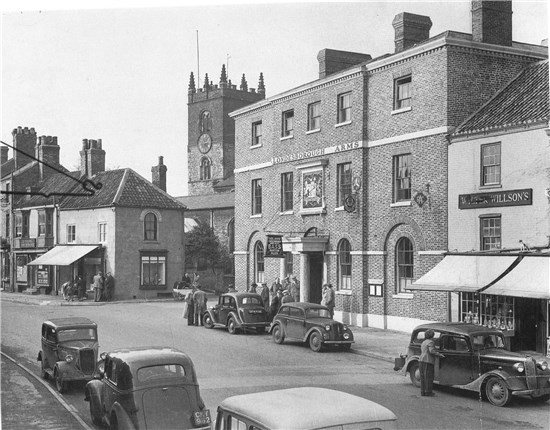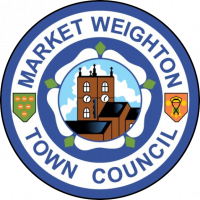A Brief History of Market Weighton
Image source www.hullcc.gov.uk
Roman
Market Weighton occupies the site of a Roman settlement. There have been a number of Roman finds in and around the town, and archaeological evidence, though far from conclusive, tells us that some form of civilisation has existed in the area for at least 7,000 years. The town lies in the angle of two Roman Roads leading from York and Malton, converging at South Newbald, and going on to the Roman town of Brough on Humber.
Middle Ages
The name of the town is Anglo-Saxon in origin, meaning ‘dwelling’ or ‘dwelling place’, and indicates that there was a village here some time before the compilation of the Domesday Book of 1086, when Market Weighton is referred to as ‘Wicstun’, a district of 15 villages and 117 farms valued at £30. Held by the King, it was the chief settlement of ‘Wicstun Hundred‘ (see notes).
In 1251 the town was granted a royal charter by Henry III and became a Market Town, with weekly markets being held on Thursdays. The charter was awarded to acknowledge the geographical importance of the town as a junction of two early routes between the Wolds and the Vale of York. Two hundred years later, in 1458, this was superseded by a charter granted to Henry Broomfleet, Ist Lord Vescy, for a market on Wednesdays, and annual fairs on 3rd May and 14th September. (After 1752, these fairs were held on 14th May and 25th September).
Like many other towns and villages in the region at the time, Market Weighton relied on its weekly markets and less frequent fairs to maintain its regional standing and prosperity, and was described by the antiquary John Leland in the early 16th century as “a great uplandish village”.
The town’s markets and fairs gave the town its particular character, and no doubt its street plan dates from the early Middle Ages, The wide main street and market place would have accommodated the market, and the streets leading from these areas – Northgate, Southgate, Finkle Street and Hungate (now Spring Road) all bear medieval names. All Saints’ Church, with features from the 11th, 13th and 15th centuries, is the only surviving building which dates from the Middle Ages and has Grade I Listed Building status.
Post Medieval
In the late 17th century, the town consisted of some 140 houses and had a population of about 650. It was distinctly semi-urban in character, with a high proportion of the townspeople engaged in trade, crafts and services, while keeping a working interest in agriculture. Weaving, tanning, malsting, shoe making, milling, tailoring, inn keeping and shop keeping were amongst the prominent trades and crafts. Weaving was linen-weaving using the coarse hemp which was grown in considerable quantities in the Vale of York and marketed at Market Weighton, where one area of the market place was designated the Hemp Market.
In 1697 the indefatigable traveller Celia Fiennes passed through the town, which she described as “a neat little thatched town”. Twenty years later the artist Samuel Buck (1696 – 1779) made an uncompleted sketch of the town which is now in the British Library.
Georgian
By the mid 18th century, the town had altered little in size or in its fabric, but this was soon to change. This expansion was due, in part, to the general increase in population between 1780 and 1850, but in the case of Market Weighton, a number of other significant factors were involved.
Firstly, the town’s importance as a marketing centre was enhanced by the great agricultural improvements taking place in the area at the time. The enclosing of the open arable fields, and the enclosing and draining of the extensive commons to the south increased the arable area and its productivity.
Secondly, the communications of the town were considerably improved with the ‘turnpiking‘ (see notes) of the road from Beverley to York in 1764 – 1765 and the digging of the Market Weighton Canal 1772 – 1782. Although the canal stopped two miles short of the town, it had an important impact on its prosperity, enabling the grain from the markets to be shipped to the expanding towns of the West Riding. This increase in trade was noted in the Universal British Directory published between 1791 and 1798 which records Market Weighton had “a great corn market, although one sees but little of that commodity exposed for sale; for some thousands of bushels are weekly disposed of by sample”. The September fair is noted both for its cheese and the vast numbers of sheep shown at it, and in 1812 H E Strickland described it as “the largest and most valuable sheep fair in the north of England, there being frequently from 70,000 to 80,000 large and nearly fat sheep upon the ground”.
Between 1764 and 1851 some 300 new houses were erected in the town, and the greater part of the then existing properties rebuilt, the most elegant building to survive from this period being the Londesborough Arms Hotel, of which the writer in the Universal British Directory says “The chief inn, (the New King’s Arms), built about fifteen years ago by the Duke of Devonshire, is a spacious, elegant, and (it may with justice be added) magnificent structure…” (Inns were important features of a market town, with the chief inn usually acting as the corn exchange, as was the case in Market Weighton. There were 12 other public houses in the town, reaching a total of 17 in 1840. Other than the Londesborough Arms the only ones to survive from the late 18th century are the Half Moon, the Griffin and the Bay Horse).
Contemporary with the Londesborough Arms hotel is the former Methodist Chapel built in 1786 in a yard on the south side of Market Place. Of no architectural importance, this building remains of considerable historical significance, being the earliest surviving Methodist Chapel in East Yorkshire and one in which John Wesley preached the year before his death on 2nd March 1791.
It was also during this period that perhaps Market Weighton’s most famous resident was born and lived in the town. William Bradley was born on the 10th February 1787, the fourth of thirteen children. By the time he was 20, Bradley stood a towering 7ft 9 inches tall (2.36m) and weighed 27 stones (172kg). After many years with a group of travelling showmen billed as “The Yorkshire Giant“, he retired back to Market Weighton where he died on the 30th May 1820 aged 33. Originally buried in the grounds of All Saints’ Church, he was later re-interred inside the church.
Victorian
The wholesale rebuilding of Market Weighton was almost completed when, in 1847, the railways arrived with the opening of the line from York. A large station and an adjacent station masters house were completed by the time the line from Selby was opened in 1848. The line to Beverley was completed in 1865, and that to Driffield in 1890. This marked the high point in Market Weighton’s Victorian prosperity. The town received some benefits as a junction town, but the greater mobility afforded by the railway eventually led to the decline of the markets and fairs.* The general depopulation of the countryside, and the agricultural depression of the later 19th century were significant factors leading to the decrease of the town’s population after 1861, a trend which continued until after the First World War.
*(The only evidence of the railway’s existence today following its closure in November 1965, and the demolition of the station buildings in 1979, are Station Road within the town, and the Hudson Way – a public footpath and bridleway tracing the route from the town to Beverley)
Modern Times
The most significant event in recent times which changed the character of the town was the opening of a by-pass, which took the busy A1079 trunk road away from the town centre. For many years the town was dissected by the old Hull to York road, and residents found it almost impossible to cross the local high street because of the heavy traffic. The opening of the new road on 11th March 1991 brought much relief and a breath of fresh air to the town.




